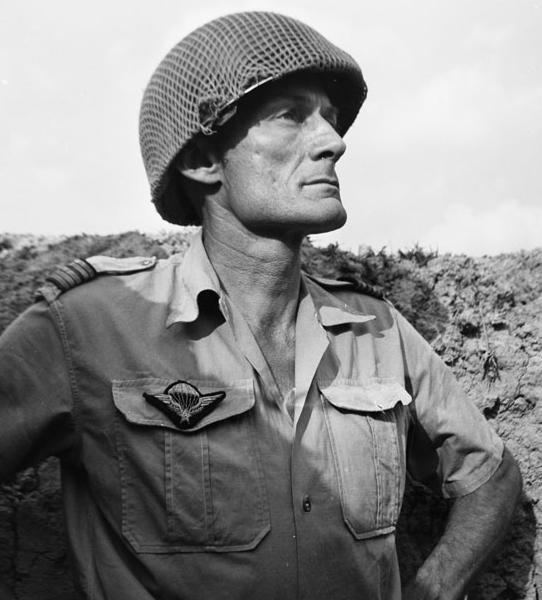Name Pierre Langlais Other work Author | Rank General de brigade Years of service 1930–65 | |
 | ||
Unit Compagnie MeharistesBattalion of the 9th Colonial Infantry Division (9e DIC)1st Colonial Half-Brigade Paratroop Commandos2nd Airborne Brigade (GAP2)20th Airborne Brigade Battles/wars World War IIItalian CampaignLiberation of FranceBattle of the Colmar PocketFirst Indochina WarBattle of HanoiOperation CastorBattle of Dien Bien Phu Education Ecole speciale militaire de Saint-Cyr Awards Legion of Honour, Croix de guerre 1939–1945, Croix de guerre des theatres d'operations exterieures Similar People Christian de Castries, Rene Cogny, Henri Navarre, Vo Nguyen Giap, Hoang Van Thai | ||
Pierre Langlais
Pierre Charles Albert Marie Langlais (Pontivy, Morbihan 2 December 1909 – 17 July 1986) was a French military officer who fought in World War II and Indochina. He is best known as the de facto commander of the French garrison during the Battle of Dien Bien Phu.
Contents

Early life
Langlais was born at Pontivy, in Morbihan, Brittany. He attended St Cyr Military Academy and graduated in 1930. He chose to serve in the Compagnies Méharistes in North Africa patrolling the Sahara.
World War II
Langlais stayed in North Africa after the fall of France in 1940. Following the defeat of the Vichy French forces in Operation Torch, he joined the French Expeditionary Corps and saw action in Italy. He then passed into the French First Army under the command of General Jean de Lattre de Tassigny, seeing action in Alsace and Germany.
Indochina
Langlais arrived in Indochina as a Battalion Commander in the 9th Colonial Infantry Division (9e DIC) in October 1945. His battalion participated in the early battles of the First Indochina War, including the Battle of Hanoi in December 1946.
Langlais returned to Indochina for a second two-year tour of duty in 1949. Assigned to the Chinese border area he watched the defeat of the last remaining units of the Kuomintang armies on the mainland.
Returning to France, in October 1951 Langlais was given command of the 1st Colonial Para-Commando Demi Brigade (1 DBCCP), training replacements for Indochina. The unit was previously commanded by Jean Gilles. In order to take this assignment Langlais trained as a paratrooper.
Returning to Indochina in June 1953 for his third tour, Lt. Col. Langlais was given command of Groupement Aéroporté 2 (GAP 2), (Airborne Group 2), comprising:
Dien Bien Phu
On 21 November 1953 Langlais and GAP 2 took part in Operation Castor, the seizing of the Dien Bien Phu valley. Langlais jumped with the men of the 1 BEP, but badly injured his ankle on landing and had to be evacuated to Hanoi the following day. Langlais returned to Dien Bien Phu with his foot in plaster on 12 December 1953 to take command of all airborne forces in the valley he immediately joined GAP 2 in the field on an operation along the Pavie Track to relieve the garrison at Mường Pồn. The operation was a failure; GAP 2 was repeatedly ambushed along the Pavie Track and it reached Muong Pon after the garrison had been overrun. The return to Dien Bien Phu was harassed by frequent Viet Minh ambushes and artillery fire. On 21 December GAP 2 launched another reconnaissance raid called Operation Regate to the Laotian town of Sop-Nao to link up with a Laotian-Moroccan-French force coming from Laos, the 50 mile route was extremely difficult with mountainous terrain cut by deep ravines and numerous rivers. The link-up was achieved on 23 December and GAP 2 then returned via a different (and worse) route to Dien Bien Phu, arriving back in the valley on 26 December. Langlais' report on the operation left no doubt that long range offensive operations from Dien Bien Phu were not feasible. Langlais' advice was ignored and offensive operations continued through January and into February 1954 although the tightening Viet Minh siege ring meant that raids were increasingly encountering Viet Minh forces within a few kilometres from the central position at Dien Bien Phu. On 17 February, faced with ongoing losses to the garrison, General René Cogny ordered that henceforth only light reconnaissances be conducted by limited numbers of personnel. On 11 March Langlais led GAP 2 on its last large reconnaissance operation against Viet Minh trenches being dug on Hill 555 overlooking Strongpoint Beatrice, only 3.2 km from the central position, the raid was a failure.
At 17:00 on 13 March 1954 Langlais was taking a shower when the Viet Minh artillery barrage that signalled the start of the battle began. Langlais ran to his command post and got in contact with his subordinate units. At 17:30 a shell hit Langlais' command post, burying the occupants under sand and timber; they had just dug themselves out when a second shell scored a direct hit, but fortunately it was a dud. At 19:50 Colonel de Castries phoned Langlais to inform him that Lieutenant Colonel Gaucher had been killed with his entire staff and that Langlais was now in command of the central sector.
Post-war career
By 1966, Langlais had been promoted to brigadier general, and commanded the 20th Airborne Brigade at Pau, Pyrénées-Atlantiques.
Death
In 1986, in failing health and depressed, Langlais committed suicide by jumping from an apartment window in Vannes, 17 July.
Works
Langlais wrote a book about his experience at Dien Bien Phu:
